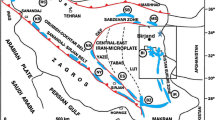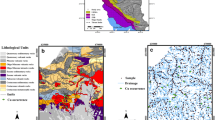Abstract
The processing and analysis of airborne geophysical data for polymetallic mineralization in Aghkand area at East Azerbaijan Province (NW Iran) were carried out with a view to establishing the prospective mineralized zones. This was done in two stages: (i) The magnetic and radiometric data were used to produce different maps including total magnetic intensity (TMI), reduction to the pole (RTP), magnetic lineation, intrusive, ternary, alteration, and other maps as well as the updated geological map of the area which when correlated with the geological map shows the concentration of potential areas at the western part; and (ii) the fractal model of concentration-area (C-A) was applied to find the main anomalous areas of RTP map, and the results were checked with geological units. The main anomalous areas in the RTP map were found from the western to the southwestern part of the area, consisting of andesite, tuffs, and dacite rocks. For validation purposes, the log-ratio matrix was used to correlate the main anomalous areas derived from the RTP map with mineral potential map. The prospective map of potential polymetallic mineralization was developed through integration of different exploration datasets using step-wise weight assessment ratio analysis (SWARA). The overall accuracy rate of RTP map when correlated with mineral potential map is 99%. Results are in good compliance with airborne geophysics data and indicate the presence of intrusive masses which is probably located in the western part of the study area.








Similar content being viewed by others
References
Afzal P, Khakzad A, Moarefvand P, Rashidnejad Omran N, Esfandiari B, Fadakar Alghalandis Y (2010) Geochemical anomaly separation by multifractal modeling in Kahang. J Geochem Explor 104:34–46
Afzal P, Alhoseini SH, Tokhmechi B, Kaveh Ahangaran D, Yasrebi AB, Madani N, Wetherelt A (2014) Outlining of high quality coking coal by concentration–volume fractal model and turning bands simulation in east-Parvadeh coal deposit. Central Iran International Journal of Coal Geology 127:88–99
Afzal P, Mirzaei M, Yousefi M, Adib A, Khalajmasoumi M, Zia Zarifi A, Foster P, Yasrebi A (2016) Delineation of geochemical anomalies based on stream sediment data utilizing fractal modeling and staged factor analysis. J Afr Earth Sci 119:139–149
Afzal P, Heidari SM, Ghaderi M, Yasrebi AB (2017) Determination of mineralization stages using correlation between geochemical fractal modeling and geological data in Arabshah sedimentary rock-hosted epithermal gold deposit, NW Iran. Ore Geol Rev 91:278–295
Aliyari F, Rastad E, Arehart GB (2009) Geology and geochemistry of DO-C isotope systematics of the Qolqoleh gold deposit, northwestern Iran; implications for ore genesis. Ore Geol Rev 36:306–314
Almasi AR, Jafarirad AR, Kheyrollahi H, Rahimi M, Afzal P (2014) Evaluation of structural and geological factors in orogenic gold type mineralisation in the Kervian area, north-West Iran, using airborne geophysical data. Explor Geophys 45:261–270
Almasi AR, Jafarirad AR, Afzal P, Rahimi M (2015) Prospecting of gold mineralization in Saqez area (NWIran) using geochemical, geophysical and geological studies based on multifractal modelling and principal component analysis. Arab Journal of Geoscience 8:5935–5947
Asadi S, Moore F, Zarasvandi A (2014) Discriminating productive and barren porphyry copper deposits in the southeastern part of the central Iranian volcano-plutonic belt, Kerman region, Iran: a review. Earth Sci Rev 138:25–46
Atapour H, Aftabi A (2007) The geochemistry of gossans associated with Sarcheshmeh porphyry copper deposit, Rafsanjan, Kerman, Iran: implications for exploration and the environment. Journal of Geochem Explor 93:47–65
Austin JR, Blenkinsop TG (2008) The Cloncurry lineament: geophysical and geological evidence for a deep crustal structure in the Eastern succession of the Mount Isa inlier. Precambrian Res 163:50–68
Austin JR, Blenkinsop TG (2009) Local to regional scale structural controls on mineralisation and the importance of a major lineament in the eastern Mount Isa inlier, Australia: review and analysis with autocorrelation and weights of evidence. Ore Geol Rev 35:298–316
Babaie HA, Ghazi AM, Babaei A, La Tour TE, Hassanipak AA (2001) Geochemistry of arc volcanic rocks of the Zagros crush zone, Neyriz, Iran. J Asian Earth Sci 19:61–76
Baranov V (1957) A new method for interpretation of aeromagnetic maps, pseudo-gravimetric anomalies. Geophysics 22:359–363
Betts PG, Lister GS (2002) Geodynamically indicated targeting strategy for shale-hosted massive sulfide Pb–Zn–Ag mineralisation in the Western Fold Belt, Mt. Isa terrane. Aust J Earth Sci 49:985–1010
Bierlein FP, Murphy FC, Weinberg RF, Lees T (2006) Distribution of orogenic gold deposits in relation to fault zones and gravity gradients: targeting tools applied to the Eastern Goldfields, Yilgarn Craton, Western Australia. Mineral Deposita 41:107–126
Carranza EJM (2011) Analysis and mapping of geochemical anomalies using logratio-transformed stream sediment data with censored values. Journal Geochemical Exploration 110:167–185
Cheng Q, Agterberg FP, Ballantyne SB (1994) The separation of geochemical anomalies from background by fractal methods. J Geochem Explor 51:109–130
Clark DA (1997) Magnetic petrophysics and magnetic petrology: aids to geological interpretation of magnetic surveys. AGSO J Aust Geol Geophys 17(2):83–103
Cooper GRJ, Cowan DR (2006) Enhancing potential field data using filters based on the local phase. Comput Geosci 32:1585–1591
Cooper GRJ, Cowan DR (2008) Edge enhancement of potentialfield data using normalized statistics. Geophysics 73:H1–H4
Dargahi S, Arvin M, Pan Y, Babaei A (2010) Petrogenesis of post-collisional A-type granitoids from the Urumieh–Dokhtar magmatic assemblage, Southwestern Kerman, Iran: constraints on the Arabian–Eurasian continental collision. Lithos 115:190–204
Dehnavi AR, Nasiri Aghdam I, Pradhan B, Morshed Varzandeh MH (2015) A new hybrid model using step-wise weight assessment ratio analysis (SWARA) technique and adaptive neuro-fuzzy inference system (ANFIS) for regional landslide hazard assessment in Iran. Catena 135:122–148
Ferreira F, de Castro L, Bongiolo A, de Souza J, Romeiro M (2011) Enhancement of the total horizontal gradient of magnetic anomalies using tilt derivatives: part II—application to real data. SEG Expanded Abstracts 2011:887–891f
Feumoe ANS, Ndougsa-Mbarga T, Manguelle-Dicoum E, Fairhead JD (2012) Delineation of tectonic lineaments using aeromagnetic data for the south-east Cameroon area. GEOFIZIKA 29(2):175–192
Gibson RI, Millegan PS (1998) Geology applications of gravity and magnetic: case histories. Society of Exploration Geophysicist 170:162
Goncalves MA, Mateus A, Oliveira V (2001) Geochemical anomaly separation by multifractal modeling. Journal of Geochem Exploration 72:91–114
Hashemkhani Zolfani S, Saparauskas J (2013) New application of SWARA method in prioritizing sustainability assessment indicators of energy system. Eng Econ 24:408–414
Hansen RO, Pawlowski RS (1989) Reduction to the pole at low latitudes by Wiener filtering. Geophysics 54:221–525
Heidari SM, Ghaderi M, Afzal P (2013) Delineating mineralized phases based on lithogeochemical data using multifractal model in Touzlar epithermal Au–Ag (Cu) deposit, NW Iran. Appl Geochem 31:119–132
Henson PA, Blewett RS, Roy IG, Miller JML, Czarnota K (2010) 4D architecture and tectonic evolution of the Laverton region, eastern Yilgarn Craton, Western Australia. Precambrian Res 183:338–355
Hezarkhani A, Williams-Jones AE (1998) Controls of alteration and mineralization in the Sungun porphyry copper deposit, Iran: evidence from fluid inclusions and stable isotopes. Econ Geol 93:651–670
Holden DJ, Archibald NJ, Boschetti F, Jessell MW (2000) Inferring geological structures using wavelet-based multiscale edge analysis and forward models. Explor Geophys 31(4):617–621
Karimzadeh Somarin A (2005) Petrology and geochemistry of early tertiary volcanism of the Mendejin area, Iran, and implications for magma genesis and tectonomagmatic setting. Geodin Acta 18:343–362
Karimzadeh Somarin A (2006) Geology and geochemistry of the Mendejin plutonic rocks, Mianeh, Iran. Asian Journal Earth Science 27:819–834
Karimzadeh Somarin A, Lentz DR (2008) Mineralogy, geochemistry and fluid evolution of a fossil hydrothermal system in the Paleogene Mendejin volcanic sequence, East Azarbaijan, Iran. Miner Petrol 94:123–143
Keršulienė V, Turskis Z (2011) Integrated fuzzy multiple criteria decision making model for architect selection. Technological and Economical Development of Economy 17:645–666
Keršuliene V, Zavadskas EK, Turskis Z (2010) Selection of rational dispute resolution method by applying new step-wise weight assessment ratio analysis (Swara). Journal of Business and Economic and Management 11:243–258
Lotfi M, Karimi M (2004) Mineralization and genesis of vein type Baycheh Baq deposit (Zanjan, NW Iran). Ulum-I-Zamin 53:40–55 (In Persian with English Abstract)
Makovicky E, Topa D, Tajeddin H, Putz H, Zagler G (2013) Ferdowsiite: a new mineral from the Barika ore deposit, Iran. Can Mineral 51(5):727–734
Mendonça CA, Silva JBC (1993) A stable truncated series approximation of the reduction-to-the-pole operator. Geophysics 58:1084–1090
Mohajjel M, Fergusson CL (2000) Dextral transpression in Late Cretaceous continental collision, Sanandaj-Sirjan zone, western Iran. J Struct Geol 22:1125–1139
Mørk MBE, Mc Enroe SA, Olesen O (2002) Magnetic susceptibility of Mesozoic and Cenozoic sediments off mid Norway and the role of siderite: implications for interpretation of highresolution aeromagnetic anomalies. Mar Pet Geol 19:1115–1126
Neawsuparp K, Charusiri P, Meyers J (2005) New processing of airborne magnetic and electromagnetic data and interpretation for subsurface structures in the Loei area. Northeastern Thailand ScienceAsia 31:283–298
Oruç B, Selim HH (2011) Interpretation of magnetic data in the Sinop area of mid Black Sea, Turkey, using tilt derivative, Euler deconvolution, and discrete wavelet transform. J Appl Geophys 74:194–204
Rajagopalan S (2003) Analytic signal vs. reduction to pole: solutions for low magnetic latitudes. Explor Geophys 34:257–262
Robert F, Brommecker R, Bourne BT, Dobak PJ, McEwan CJ, Rowe RR, Zhou X (2007) Models and exploration methods for major gold deposit types. In: Milkereit B (ed) Proceedings of exploration 07: Fifth Decennial International Conference on Mineral Exploration, Abstracts Volume: 691–711
Shahabpour J (2009) Recycling of orogenic arc crust triggers porphyry Cu mineralization in Kerman Cenozoic arc rocks, southeastern Iran. Mineral Deposita 44(3):265–283
Sillitoe RH (2000) Role of gold-rich porphyry models in exploration. In: Hagerman SG, Brown PH (eds) Gold in 2000. Rev Econ Geol 13:311–346
Silva JBC (1986) Reduction to the pole as an inverse problem and its application to low‐latitude anomalies. Geophysics 51:221–525
Tajeddin H (2011) Gold ore controlling factors in metamorphic rocks of Saqez–Sardasht, NW of Sananda–Sirjan metamorphic zone. Ph.D. Dissertation, Tarbiat Modarres University, Tehran, Iran, 436 pp
Vafaeipour M, Hashemkhani Zolfani S, Morshed Varzandeh MH, Derakhti A, Keshavarz Eshkalag M (2014) Assessment of regions priority for implementation of solar projects in Iran: new application of a hybrid multi-criteria decision making approach. Energy Convers Manag 86:653–663
Verduzco B, Fairhead JD, Green CM, MacKenzie C (2004) New insights into magnetic derivatives for structural mapping. Lead Edge 23:116–119
Zarasvandi A, Rezaei M, Raith J, Lentz D, Azimzadeh AM, Pourkaseb H (2015) Geochemistry and fluid characteristics of the Dalli porphyry Cu–Au deposit, Central Iran. J Asian Earth Sci 111:175–191
Acknowledgements
The authors would like to thank Mahdi Panahi because of his help and his constructive and valuable advice on integration of the discovered layers.
Author information
Authors and Affiliations
Corresponding author
Additional information
Editorial handling: Hesham El-Araby
Publisher’s note
Springer Nature remains neutral with regard to jurisdictional claims in published maps and institutional affiliations.
Rights and permissions
About this article
Cite this article
Shahsavar, S., Jafari Rad, A., Afzal, P. et al. Prospecting for polymetallic mineralization using step-wise weight assessment ratio analysis (SWARA) and fractal modeling in Aghkand Area, NW Iran. Arab J Geosci 12, 248 (2019). https://doi.org/10.1007/s12517-019-4304-5
Received:
Accepted:
Published:
DOI: https://doi.org/10.1007/s12517-019-4304-5




